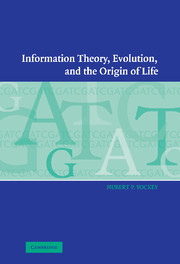Book contents
- Frontmatter
- Contents
- Preface
- 1 The genetic information system
- 2 James Watson, Francis Crick, George Gamow, and the genetic code
- 3 The Central Dogma of molecular biology
- 4 The measure of the information content in the genetic message
- 5 Communication of information from the genome to the proteome
- 6 The information content or complexity of protein families
- 7 Evolution of the genetic code and its modern characteristics
- 8 Haeckel's Urschleim and the role of the Central Dogma in the origin of life
- 9 Philosophical approaches to the origin of life
- 10 The error catastrophe and the hypercycles of Eigen and Schuster
- 11 Randomness, complexity, the unknowable, and the impossible
- 12 Does evolution need an intelligent designer?
- 13 Epilogue
- Mathematical appendix
- Glossary
- References
- Index
3 - The Central Dogma of molecular biology
Published online by Cambridge University Press: 15 August 2009
- Frontmatter
- Contents
- Preface
- 1 The genetic information system
- 2 James Watson, Francis Crick, George Gamow, and the genetic code
- 3 The Central Dogma of molecular biology
- 4 The measure of the information content in the genetic message
- 5 Communication of information from the genome to the proteome
- 6 The information content or complexity of protein families
- 7 Evolution of the genetic code and its modern characteristics
- 8 Haeckel's Urschleim and the role of the Central Dogma in the origin of life
- 9 Philosophical approaches to the origin of life
- 10 The error catastrophe and the hypercycles of Eigen and Schuster
- 11 Randomness, complexity, the unknowable, and the impossible
- 12 Does evolution need an intelligent designer?
- 13 Epilogue
- Mathematical appendix
- Glossary
- References
- Index
Summary
Ah, but my Computations, People say,
Have squared the year to human compass, eh?
If so by striking from the calendar
Unknown tomorrow and dead Yesterday.
The Rubaiyat of Omar Khayyam (Fitzgerald, Second Edition)Francis Crick and the Central Dogma
Francis Crick (1958) published The Central Dogma, stating his view of how DNA, mRNA and protein interact. The Central Dogma states that information can be transferred from DNA to DNA, DNA to mRNA and mRNA to protein. Three transfers that the Central Dogma states never occur are protein to protein, protein to DNA, protein to mRNA.
On the other hand, the discovery of just one type of present day cell which could carry out any of the three unknown transfers would shake the whole intellectual basis of molecular biology, and it is for this reason that the central dogma is as important as when first proposed.
(Crick, 1970)Crick need not have worried. He emphasized, correctly, that there is no flow of matter, but, rather, “… sequence information from one polymer molecule to another.” I wrote to Professor Crick (private correspondence, 2002) congratulating him on the Central Dogma. He replied that he believed that the Central Dogma is only an hypothesis. I have shown long ago that Professor Crick hath wrought better than he knew (Yockey 1974, 1978, 1992, 2002).
The Shannon entropy criterion for codes that transfer messages in one alphabet to another
The genetic code has a Central Dogma because it is redundant.
- Type
- Chapter
- Information
- Information Theory, Evolution, and the Origin of Life , pp. 20 - 26Publisher: Cambridge University PressPrint publication year: 2005
- 2
- Cited by



